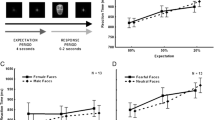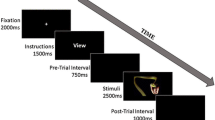Abstract
Subjects high and low in temperamental fearfulness made a speeded decision regarding whether each of a series of affective pictures was “unpleasant” or “pleasant.” Fearful subjects made faster decisions on unpleasant pictures than did low fear subjects, whereas no difference was found between low and high fear participants when processing pleasant materials. Reaction time differences as a function of fearfulness were amplified when unpleasant pictures were also high in arousal, suggesting that stimulus intensity is a relevant methodological factor when assessing effects of temperament in cognitive processing. Taken together, these data are consistent with the hypothesis that an anxious or fearful temperament is associated with rapid reactions to unpleasant events.
Similar content being viewed by others
REFERENCES
Bonnet, M., Bradley, M. M., Lang, P. J., & Requin, J. (1995). Emotion and spinal reflex action. Psychophysiology, 32, 367–372.
Bradley, M. M., Greenwald, M. K., & Hamm, A. O. (1993). Affective picture processing. In N. Birbaumer & A. Öhman (Eds.), The structure of emotion: Psychophysiological, cognitive, and clinical aspects (pp. 48–65). Toronto: Hogrefe & Huber.
Bradley, M. M., & Lang, P. J. (1992). Temperament and emotional reactivity: Sociability, fear and restraint. Psychophysiology, 29, S22.
Bradley, M. M., & Lang, P. J. (in press). Measuring emotion: Behavior, feeling, and physiology. In R. Lane & L. Nadel (Eds.), Cognitive neuroscience of emotion. Oxford University Press.
Buss, A. H., & Plomin, R. (1975). A temperament theory of personality development. New York: Wiley.
Buss, A. H., & Plomin, R. (1984). Temperament: Early developing personality traits. Hillsdale, NJ: Erlbaum.
Byrne, A., & Eysenck, M. W. (1995). Trait anxiety, anxious mood, and threat detection. Cognition and Emotion, 9, 549–562.
Center for the Study of Emotion and Attention (CSEA) (1999). The international affective picture system. Photographic slides. Gainesville, FL: The Center for Research in Psychophysiology, University of Florida.
Dalgleish, T., & Watts, F. N. (1990). Biases of attention and memory in disorders of anxiety and depression. Clinical Psychology Review, 10, 589–604.
Derryberry, D., & Rothbart, M. K. (1988). Arousal, affect, and attention as components of temperament. Journal of Personality and Social Psychology, 55, 953–966.
Dombek, M. J., & Ingram, R. E. (1993). Cognitive conceptions in anxiety. In K. S. Dobson & P. C. Kendall (Eds.), Psychopathology and Cognition (pp. 54–80). San Diego: Academic Press.
Eysenck, M. W. (1992). Anxiety: The cognitive perspective. Hove, UK: Erlbaum.
Greenwald, M. K., Cook, E. W., & Lang, P. J. (1989). Affective judgment and psychophysiological response: Dimensional covariation in the evaluation of pictorial stimuli. Journal of Psychophysiology, 3, 51–64.
Lang, P. J., Bradley, M. M., & Cuthbert, B. N. (1990). Emotion, attention, and the startle reflex. Psychological Review, 97, 377–398.
Lang, P. J., Bradley, M. M., & Cuthbert, B. N. (1999). The international affective picture system (IAPS). Technical manual and affective ratings. Gainesville, FL: University of Florida.
Lang, P. J., Bradley, M. M., & Cuthbert, B. N. (1997). Motivated attention: Affect, activation, and action. In P. J. Lang, R. F. Simons, & M. T. Balaban (Eds.), Attention and orienting: Sensory and motivational processes (pp. 97–136). Mahwah, NJ: Erlbaum.
Lang, P. J., Greenwald, M. K., Bradley, M. M., & Hamm, A. O. (1993). Looking at pictures: Affective, facial, visceral, and behavioral reactions. Psychophysiology, 30, 261–273.
Mathews, A., & Milroy, R. (1994). Processing of emotional meaning in anxiety. Cognition and Emotion, 8, 535–553.
Mineka, S., & Sutton, S. K. (1992). Cognitive biases and the emotional disorders. Psychological Science, 3, 65–69.
Öhman, A. (1997). As fast as the blink of an eye: Evolutionary preparedness for preattentive processing of threat. In P. J. Lang, R. F. Simons, & M. T. Balaban (Eds.), Attention and orienting: Sensory and motivational processes (pp. 165–184). Mahwah, NJ: Lawrence Erlbaum Associates.
Strelau, J. (1991). Renaissance in research on temperament: Where to? In J. Strelau & A. Angleitner (Eds.), Explorations in temperament: International perspectives on theory and measurement (pp. 337–359). New York: Plenum Press.
Watson, D., & Clark, L. A. (1984). Negative affectivity: The disposition to experience aversive emotional states. Psychological Bulletin, 96, 465–490.
Watson, D., & Tellegen, A. (1985). Toward a consensual structure of mood. Psychological Bulletin, 98, 219–235.
Watson, D., Clark, L. A., & Mineka, S. (1994). Temperament, personality, and the mood and anxiety disorders. Journal of Abnormal Psychology, 103, 103–116.
Winton, E. C., Clark, D. M., & Edelmann, R. J. (1995). Social anxiety, fear of negative evaluation and the detection of negative emotion in others. Behaviour Research & Therapy, 33, 193–196.
Author information
Authors and Affiliations
Rights and permissions
About this article
Cite this article
Bradley, M.M., Lang, P.J. Fearfulness and Affective Evaluations of Pictures. Motivation and Emotion 23, 1–13 (1999). https://doi.org/10.1023/A:1021375216854
Issue Date:
DOI: https://doi.org/10.1023/A:1021375216854




